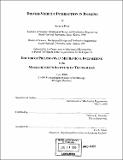| dc.contributor.advisor | Thomas B. Sheridan. | en_US |
| dc.contributor.author | Park, Shinsuk, 1966- | en_US |
| dc.date.accessioned | 2005-08-22T18:14:09Z | |
| dc.date.available | 2005-08-22T18:14:09Z | |
| dc.date.copyright | 1999 | en_US |
| dc.date.issued | 1999 | en_US |
| dc.identifier.uri | http://hdl.handle.net/1721.1/9421 | |
| dc.description | Thesis (Ph.D.)--Massachusetts Institute of Technology, Dept. of Mechanical Engineering, 1999. | en_US |
| dc.description | Includes bibliographical references (leaves 81-86). | en_US |
| dc.description.abstract | While antilock brake systems (ABS) have become more and more popular with the public, statistics reports imply that ABS-equipped cars have no advantage over non-ABS-equipped cars in reducing fatal accidents. While the brake pedal needs to be pushed down (full-brake) to activate the ABS, many drivers on ABS-equipped cars fail to do this simple maneuver, reducing the effectiveness of ABS and even contributing to some accidents. Because of such behavior on the driver's part, the major feature of this brake assistance system is often ineffective. The goal of this thesis is to design brake systems that provide intuitive brake control and proper braking performance information for the driver. As a preliminary study in brake system design, the characteristics of human leg motion and its underlying motor control scheme were studied through experiments and simulations. Automotive brake systems were modeled as a type of master-slave tele-manipulator. Human force-displacement interaction at the master end (the brake pedal) has a strong effect on the system's ability to control the operations at the slave end (the braking performance). By providing drivers with "force feel" at the brake pedal, they can obtain information about braking conditions or performance. This thesis developed novel brake systems based on two new aspects. First, the mechanical impedance characteristics of the leg action of the driver were taken into consideration in designing the brake systems. Second, the brake systems provide the driver with kinesthetic feedback of braking conditions or performance. Since the effectiveness of brake systems needs to be examined as a combined driver-vehicle system, driving simulations were used to investigate the performance of the proposed designs. | en_US |
| dc.description.statementofresponsibility | by Shinsuk Park. | en_US |
| dc.format.extent | 86 leaves | en_US |
| dc.format.extent | 5512939 bytes | |
| dc.format.extent | 5512699 bytes | |
| dc.format.mimetype | application/pdf | |
| dc.format.mimetype | application/pdf | |
| dc.language.iso | eng | en_US |
| dc.publisher | Massachusetts Institute of Technology | en_US |
| dc.rights | M.I.T. theses are protected by copyright. They may be viewed from this source for any purpose, but reproduction or distribution in any format is prohibited without written permission. See provided URL for inquiries about permission. | en_US |
| dc.rights.uri | http://dspace.mit.edu/handle/1721.1/7582 | |
| dc.subject | Mechanical Engineering | en_US |
| dc.title | Driver-vehicle interaction in braking | en_US |
| dc.type | Thesis | en_US |
| dc.description.degree | Ph.D. | en_US |
| dc.contributor.department | Massachusetts Institute of Technology. Department of Mechanical Engineering | en_US |
| dc.identifier.oclc | 43319851 | en_US |
